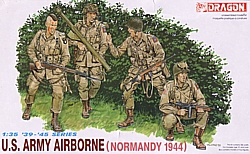| U.S.
Army Airborne (Normandy, 1944) |
 |
|
This kit came out in 1992 and blew a lot of modelers away because U.S. paratroopers had always been an overlooked segment. And they remained pretty much ignored until the HBO film "Band of Brothers" premiered in 2001. The problem is the inclination of diorama builders to tie U.S. figures to U.S. AFVs, and there is not much well known interaction of airborne troops with tanks. But these figures can be used, with some ingenuity and additional resin offerings, as the focal point of some exciting dioramas. Frankly, I haven't seen any yet, which gives me even more reason to take this set I bought back in 1992 and do something with them! These four are a familiar quartet on hobby store shelves. Dressed in the M1942 uniform that was seen in North Africa and Sicily as well as Normandy, they represent a mixed group of the 82nd Airborne Division and a lone Mohawk-sporting soldier from the 101st Airborne Division. The well-known problems with the airdrops resulted in many instances where men from the two divisions found themselves together, trying to find their respective units. The markings are not molded onto the sleeves of the figures, so you are not forced to represent the two units. Paratrooper markings are available as decals from Hudson & Allen and as dry transfers from Archer Fine Transfers. (Box art illustrator Ron Volstad stated in 2001 on one of the online discussion groups that he erred in portraying the soldier from the 101st wearing an American flag in Normandy; further research since 1992 and the absence photos showing the flag patch actually on the soldiers in the field has him convinced that his illustration is incorrect.) The soldiers are well equipped for D-Day and the fighting that followed. The crouching soldier with the Thompson M1 submachine gun carries a bag of spare ammo magazines. The beckoning officer has both a fragmentation and smoke grenade hanging from his web straps and an M1938 dispatch case slung on his left hip, and a Colt .45. The bazooka man (who looks a lot like the cigar-chomping Elliot Gould in "A Bridge Too Far") carries a couple rockets under the flap of his M1936 musette bag, and the clever two-piece bag creates a nicely dimensional rendering. He also has an M1A1 carbine with the collapsible stock on his shoulder and a holstered Colt .45. The final figure moves forward warily with his distinctive haircut and snarling face, a bayonet on his M1 Garand. He has a M1910 entrenching tool, while the others carry the folding M1943 model (with a too narrow blade). Other gear to attach includes canteens, ammo pouches, and an M3 trench knife. These figures are sculpted and molded quite well for plastic, though there are the requisite mold seams to clean up. The heads, even for the officer and rifleman, are rather placid and could be easily replaced with others from Hornet or Ultracast. The figures scale to over 6' tall. Helmet sizes are similar to Tamiya, and smaller than typical Warriors helmets (or some other DML figures). Weapons and gear are also nicely rendered, with the exception of the M1943 tool. Because these figures are molded with separate torsos, legs, and arms, you can mix and match and create additional soldiers for a well-populated diorama. So shout "Curahee!" and go out and buy yourself a few sets. -tss- |
 |
 |
 |
 |
 |
 |
 |
 |
 |
 |
 |
 |
|
